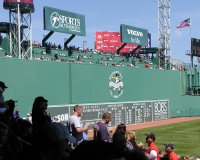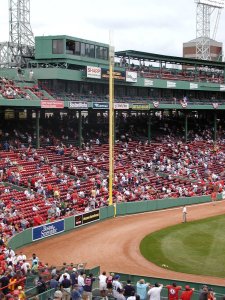
Fenway Park was built at a cost of $650,000 and debuted on 20 April 1912, with the Red Sox beating the New York Highlanders (later to become the Yankees), 6-5. That would have been front-page news in the Boston newspapers except that the sinking of the Titanic became the lead story.
Fenway opened with a maximum capacity of 35,000 fans and, thanks to recent expansion, holds just under 40,000 today, making it the third-smallest ballpark in terms of capacity behind Pittsburgh’s PNC Park and Oakland’s McAfee Coliseum. The largest crowd ever to witness a game at Fenway was 47,627 people who crammed into the park to watch Boston take on the New York Yankees in a doubleheader on 22 September 1935, but fire laws now prevent those figures from ever being seen again. 2008 was the first season that the team drew over three million fans to the park.
The left field wall was originally made of wood and was 25 feet high when the park opened. More than twenty years later, in 1934, the height of the wall was raised to just over 37 feet and was constructed of tin that covered wood over a concrete lower section. The wall was originally plastered with advertisements, as was common in ballparks at the time, but team owner Tom Yawkey had the signs painted over with green paint in 1947 to give the wall its distinctive color seen today (earning it the nickname, “The Green Monster”).
In 1976, the wall was rebuilt out of hard plastic and six-foot-tall crash pads were installed at the base of the wall to minimize the risk of injury to outfielders, especially after Red Sox player Fred Lynn crashed into it during the 1975 World Series. The netting that was used to catch fly balls hit over the wall was installed in 1936, but was removed after the Monster Seats were added in 2003.

The wall also boasts a manual scoreboard which shows the score inning-by-inning, the current pitchers for each team, the current batter, the count, and the number of outs. Out-of-town scores are also posted, but the operators are notorious for being slow to update these games as they keep abreast of the action on the field.
The bullpens that sit in right field were originally placed in foul ground on either side of the outfield foul lines but they were moved to the present location in 1940, thereby bringing the right field fence in 23 feet. Sportswriters began to refer to this area of the park as “Williamsburg” as it provided more favorable conditions for then-rising star Ted Williams and other left-handed batters the opportunity to launch pitches for home runs. The name also played on Yankee Stadium’s cozy right-field section that was often called “Ruthville” in honor of the former slugging great, Babe Ruth.
Lights were installed in 1947 as the Red Sox became the third-to-last major league team to play night games. Other features added later include an electronic message board about the center field bleachers in 1976, private suites built on the roof in 1983, and the glass-enclosed 600 Club (later the .406 Club) behind home plate in 1988, which has since been replaced with the open-air EMC Club. The Red Sox organization has also added other features that are found in modern ballparks, like rotating advertisements behind home plate, electronic pitch speed boards, and several additional electronic message boards. The Green Monster now also sports several advertisements on the lower-half of the wall, but these have been added to “blend in” rather than strike a contrast.
Fenway has hosted other tenants, including the American Football League Boston Patriots (now the New England Patriots) between 1963 and 1968 and the National Football League Boston Redskins (later the Washington Redskins) before that. Fenway Park has also hosted three All-Star games as well as a World Series that did not include the Red Sox; the Boston Braves used it for the 1914 championship series against the Philadelphia Athletics because the team was awaiting construction of Braves Field after abandoning the South End Grounds. More recently, the park has hosted several special events, such as mid-summer concerts featuring acts as Bruce Springsteen, The Rolling Stones, and the Police as well as the 2010 National Hockey League Winter Classic between the hometown Boston Bruins and the Philadelphia Flyers.
For more great information that pertains to Fenway Park’s history, visit Ballparks.com.